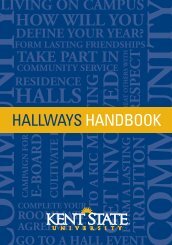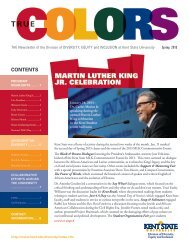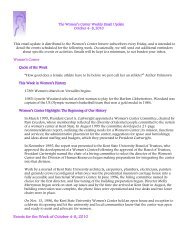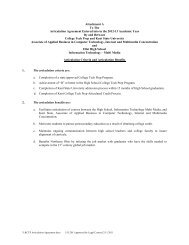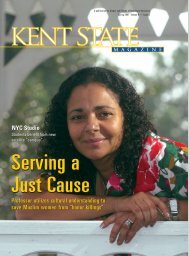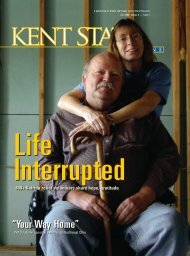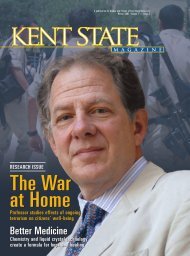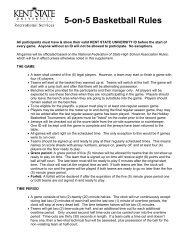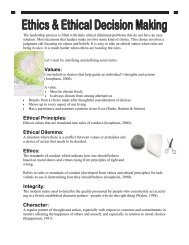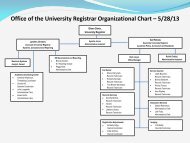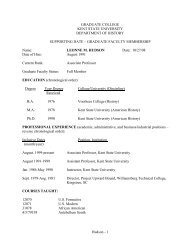Greetings from the Chair - Kent State University
Greetings from the Chair - Kent State University
Greetings from the Chair - Kent State University
You also want an ePaper? Increase the reach of your titles
YUMPU automatically turns print PDFs into web optimized ePapers that Google loves.
I N S I D E T H I S I S S U E :<br />
Scholarship Awardees 2<br />
Photo Competition 3<br />
Department News Items 4-5<br />
Professors’ Updates 6<br />
Emeritus Updates 15<br />
View our website at http://www.kent.edu/geology<br />
<strong>Greetings</strong> <strong>from</strong> <strong>the</strong> <strong>Chair</strong><br />
June 2012<br />
It has been a banner year<br />
for Geology in nor<strong>the</strong>ast Ohio<br />
and at <strong>Kent</strong> <strong>State</strong>. We experienced<br />
a decent size New Year‘s<br />
Eve earthquake and saw <strong>the</strong><br />
growth of shale gas exploration<br />
and fracking. And it turns out<br />
that <strong>the</strong>se were not unrelated.<br />
Chesapeake Energy hired four<br />
of our recent graduates this year<br />
and we expect this hiring trend<br />
to increase. Perhaps not surprisingly,<br />
our undergraduate enrollment<br />
has seen exceptional<br />
growth in <strong>the</strong> past three years.<br />
We have more than doubled <strong>the</strong><br />
number of majors between Fall<br />
08 (ca. 47) and Fall 11 (ca.<br />
110). And over 50 students are<br />
enrolled in our fieldcamp course<br />
this summer!<br />
Donna Witter resigned<br />
<strong>from</strong> her faculty position last<br />
year to start her own company<br />
Sapphire Geoscience Informatics,<br />
LLC. We miss her and wish<br />
her <strong>the</strong> very best. Last summer<br />
we welcomed Annie Krieger<br />
who replaced Karen Smith as<br />
<strong>the</strong> Administrative Secretary.<br />
And I‘m delighted to report that<br />
four new faculty will be joining<br />
us very soon. Anne Jefferson<br />
(Hydrology) comes to us <strong>from</strong><br />
UNC-Charlotte where she has<br />
been an Assistant Professor.<br />
David Singer (Environmental<br />
Mineralogy) is finishing a post-<br />
doc at Berkeley National Labs<br />
and Chris Rowan (Geophysics/<br />
Paleomagnetism) is presently<br />
completing a post-doc at <strong>the</strong> <strong>University</strong><br />
of Chicago. Eric Taylor<br />
(Mineralogy/Medical Geology)<br />
who completed his Ph.D. at OSU<br />
this year will be a new Assistant<br />
Professor at Stark. We are very<br />
excited to have such a cadre of<br />
high-caliber young scientists joining<br />
<strong>the</strong> department this coming<br />
year. This year Rod Feldmann<br />
was made a Fellow of <strong>the</strong> Paleontological<br />
Society. Carrie<br />
Schweitzer and Joe Ortiz were<br />
both promoted to Full Professor.<br />
Jeremy Green won <strong>the</strong> Outstanding<br />
Teacher Award on <strong>the</strong><br />
Tuscarawas Campus and Carrie<br />
Schweitzer was a Finalist for <strong>the</strong><br />
Outstanding Teacher Award on<br />
<strong>the</strong> Stark Campus. Alison Smith<br />
became Vice <strong>Chair</strong> to <strong>the</strong> U.S.<br />
National Committee for INQUA<br />
and Don Palmer has been appointed<br />
interim Dean of <strong>the</strong><br />
Honor‘s College starting in August.<br />
Abdul Shakoor was selected<br />
to receive <strong>the</strong> 2012 GSA<br />
Meritorious Service Award <strong>from</strong><br />
<strong>the</strong> Environmental & Engineering<br />
Geology Division.<br />
We‘ve had two Geology<br />
banquets since our March 2011<br />
Newsletter. It‘s always a thrill to<br />
be able to award so many scholarships<br />
and to recognize our out-<br />
standing students at our banquets.<br />
We want to thank those who have<br />
supported us through generous<br />
contributions, many of which directly<br />
benefit our students via endowed<br />
scholarships. Special<br />
thanks to those who contributed<br />
toward <strong>the</strong> Carlson Memorial<br />
Scholarships awarded in 2011.<br />
Also, we are grateful to Joe and<br />
Karen Struckel who this year created<br />
a new endowed scholarship<br />
for our department.<br />
SAVE THE DATE!<br />
We invite our alumni to come<br />
back and visit us on Friday,<br />
October 19, <strong>the</strong> Friday before<br />
Homecoming Weekend. The<br />
geology faculty would love to<br />
catch up with you, swap stories<br />
(all true of course!), and<br />
reminisce about things geological.<br />
More information will<br />
be provided later in <strong>the</strong> summer.<br />
Meanwhile we hope you<br />
will mark <strong>the</strong> date on your<br />
calendar and contact your geology<br />
alumni friends to encourage<br />
<strong>the</strong>m to attend.<br />
Sincerely,<br />
Daniel K. Holm,<br />
Professor & <strong>Chair</strong>
Congratulations<br />
(December 2010<br />
-Summer 2012 )<br />
BS Geology:<br />
Renee Crane<br />
Jamael Sadallah<br />
Carrie Frisky<br />
Joe Kupchik<br />
Kyle Rote<br />
Rachel Thornton<br />
Matt Wayman<br />
Lindsay Brenizer<br />
Nick Piazza<br />
Pat LaQuatra<br />
Erica Strohmeyer<br />
Mike Reilly<br />
Aziza Dawaher<br />
Jessica Dorfman<br />
Tim Eyerdom<br />
Julia Yeakley<br />
Evan Hickman<br />
John Holsinger<br />
Hea<strong>the</strong>r Krivos<br />
Linda Frank<br />
Chelsea Windus<br />
Nick Resar<br />
Katie Weaver<br />
Ashley Trudeau<br />
Max Banas<br />
Josh Meeker<br />
John Burwick<br />
Paul Potesta<br />
Damien Beebout<br />
BA Geology:<br />
Joe Novak<br />
Ryan Broman<br />
M.S. Theses Completed<br />
(January 2011 –May 2012)<br />
James Fisher: Collection and analysis of<br />
structural data for design of road cuts, I-81<br />
expansion project, Virginia (Shakoor)<br />
Mandy Razzano: Monitoring Algal Production<br />
in Akron Water Supply Reservoirs in<br />
Nor<strong>the</strong>astern Ohio Using Satellite Imagery<br />
(Witter)<br />
Lisa Nowicki: Engineering Geology Considerations<br />
for Re-alignment of Interstate<br />
70/76 across <strong>the</strong> Landslide at New Baltimore,<br />
Somerset County, SW Pennsylvania<br />
(Shakoor)<br />
Nivideta Mehrotra: Reconstructions of<br />
Holocene paleoclimate based on benthic<br />
foraminiferal assemblages <strong>from</strong> Soledad<br />
Basin (Ortiz)<br />
Madan Maharjan: Interpretation of Domestic<br />
Water Well Production Data as a Tool<br />
for Detection of Bedrock Fractured Zones<br />
under Cover of <strong>the</strong> Glacial Formations in<br />
Geauga County, Ohio (Eckstein)<br />
Kathryn Wells: Paleoecology of Beringian<br />
Lacustrine Deposits as Indicated by Nor<strong>the</strong>rn<br />
Hemisphere Ostracode Biogeography<br />
(Smith)<br />
Chandawimal H.E.R. Siriwardana: Paleoclimatic<br />
characterization of Arctic Ocean<br />
Sediments around <strong>the</strong> Northwind Ridge<br />
using XRF and VNIR (Ortiz)<br />
Inoka H. Widanagamage: EMPA Dating of<br />
Monazite <strong>from</strong> High Grade Metamorphic<br />
Rocks along <strong>the</strong> Highland-Vijayan Boundary<br />
Zone, Sri Lanka (Holm)<br />
Natalie Cope: Thermochronology and Geochronology<br />
of <strong>the</strong> Otter Lake Region, QC,<br />
Central Metasedimentary Belt, Grenville<br />
Province (Holm)<br />
Wondwosen Seyoum: Hydraulic Relationships<br />
between Buried Valley Sediments and<br />
Adjacent Bedrock Formation (Eckstein)<br />
Ph.D Dissertations Completed<br />
(January 2011-May 2012)<br />
Ahmad Y. Dalqamouni: Development of a<br />
Landslide Hazard Rating System for Selected<br />
Counties in Nor<strong>the</strong>astern Ohio<br />
(Shakoor)<br />
Kay Amey: Hydrology And Predictive<br />
Model Of Headwater Streams And The<br />
Groundwater/Surface Water Interactions<br />
Supporting Brook Trout Habitat In Nor<strong>the</strong>ast<br />
Ohio (Smith)<br />
Khalid Adem Ali : Prediction of Water Quality<br />
Parameters <strong>from</strong> VIR Spectral Radiometry:<br />
Lake Erie as a Natural Laboratory for<br />
Analysis of Case 2 Waters (Ortiz and Witter)<br />
P A G E 2<br />
P A G E 2<br />
Geology Scholarship<br />
Awardees<br />
Geology Field Camp Scholarships:<br />
2012: Megan Court, Evan Green, and<br />
Lindsay Poluga<br />
2011: Rachel Thornton, Chelsea Windus,<br />
and Matt Wayman<br />
Emerald Environmental Scholarship:<br />
2012: Kimberly Benedetti<br />
2011: Lindsey Brenizer<br />
Richard A. Heimlich Scholarship:<br />
2012: Dorothy Van Oss, Julia Yeakley<br />
2011: Hea<strong>the</strong>r Krivos, Nick Resar<br />
John Allen Clark Scholarship:<br />
2012: Carl Jacklitch<br />
Bauer Experiential Learning<br />
Scholarship:<br />
2012: Samantha Yost<br />
2011: Linda Frank<br />
Joe & Karen Struckel Scholarship:<br />
2012: Anthony M. Banas<br />
Ka<strong>the</strong>rine Moulton Scholarship:<br />
2012: Ashley Tizzano<br />
2011: Ode Frantescu<br />
School of Hard Rocks Scholarship:<br />
2012: Mat<strong>the</strong>w Wayman<br />
2011: Scott Scheiner<br />
Amoco Alumni Scholarships:<br />
2012: Chelsea Lyle, AnnMarie Jones,<br />
and Nidal Atallah<br />
Donald C. Gifford Scholarship:<br />
2012: Daniel Gardner, Jessica Nester<br />
2011: Hea<strong>the</strong>r Krivos<br />
Glenn W. Frank Scholarship:<br />
2012: Hea<strong>the</strong>r James<br />
2011: Julia Yeakley, Tim Eyerdom<br />
2011 Carlson Memorial Scholarships:<br />
Mike Reilly, Nick Piazza, Julia Yeakley,<br />
Dorothy Van Oss, Lindsey Brenizer, and<br />
Linda Frank
Second Annual Student Photo Competition<br />
P A G E 3<br />
2011 First Place Winner—<br />
Scott Scheiner<br />
At <strong>the</strong> end of each summer<br />
Geology students submit<br />
photos for <strong>the</strong> Annual Student<br />
Photo Competition. The faculty<br />
select <strong>the</strong> top three photos and <strong>the</strong><br />
winning photo is selected by voting<br />
at <strong>the</strong> Geology open house<br />
during fall homecoming weekend.<br />
The 2011 winning photo was<br />
taken within <strong>the</strong> Kenai Fjords National<br />
Park by Scott Scheiner, a<br />
current MS student.<br />
Graduate Student Senate Research Symposium<br />
Congratulations to Geology graduate students at <strong>the</strong> 2011 Graduate Student Senate Research Symposium.<br />
The Geology Department was well-represented, with 7 entries in <strong>the</strong> poster and oral presentation divisions.<br />
Congratualations to Julie Gouin, who took top honors in <strong>the</strong> Master‘s degree section with her poster!<br />
In <strong>the</strong> ―nomination awards‖ categories, <strong>the</strong> Geology Department had two winners: Ovidiu Fantescu, who<br />
won ―Best Creative Endeavor,‖ and Adiel Klompmaker was awarded ―Best Research.‖<br />
A Thriller of a Discovery: Fossil Hermit Crab Named<br />
After Michael Jackson<br />
Adiël Klompmaker,a Ph.D. candidate in <strong>the</strong> Department of Geology<br />
at <strong>Kent</strong> <strong>State</strong>, displays an example of <strong>the</strong> new species of fossil hermit crab<br />
named after superstar Michael Jackson. Klompmaker was part of a team of<br />
paleontologists that made <strong>the</strong> discovery in nor<strong>the</strong>rn Spain.<br />
The team made <strong>the</strong> surprising discovery on June 25, 2009. Later that<br />
day, while meeting at a restaurant in <strong>the</strong> city of Alsasua, <strong>the</strong> group saw on<br />
TV that international superstar Michael Jackson had passed away that day.<br />
The paleontologists decided to honor <strong>the</strong> ―King of Pop‖ by <strong>the</strong> naming <strong>the</strong><br />
new species after <strong>the</strong> late music icon: Mesoparapylocheles michaeljacksoni.<br />
―Michael Jackson‘s music will no doubt live a very long time and<br />
influence many people, so I think <strong>the</strong> name is appropriate,‖ explains Adiël<br />
Klompmaker.
Chesapeake Energy Hires KSU Geology Majors<br />
P A G E 4<br />
Recent (2011) BS Geology graduates Mike Reilly, Erica Strohmeyer, Pat LaQuatra, and Rachel<br />
Thornton now work for Chesapeake Energy. All four are presently participating in <strong>the</strong> Field Geologist<br />
Development Program for Nomac Services, a subsidiary of Chesapeake Energy. The program consists of<br />
three training phases which takes nearly a year to complete, in part because of field work required in between<br />
each training phase. The program was designed specifically for recent geology graduates and involves<br />
training in basic company background, safety, and mudlogging terminology/techniques including<br />
learning specific rules for creating mudlogs, basic mudlogging interpretation and learning to identify<br />
lithologies of drill cuttings. Some of <strong>the</strong> training is here in nor<strong>the</strong>ast Ohio but some is also in Oklahoma<br />
at Chesapeake headquarters. All four recent alumni state that <strong>the</strong>y are very excited about working for<br />
Chesapeake Energy.<br />
Geology Department<br />
Homecoming Float<br />
———<br />
First Place KSU Winner<br />
This was first year in which all of <strong>the</strong> <strong>Kent</strong> <strong>State</strong> Geology student organizations banded toge<strong>the</strong>r to<br />
build a float for <strong>the</strong> KSU Homecoming parade. It was difficult to decide on a float for <strong>the</strong> parade but <strong>the</strong> final<br />
decision went back to childhood science projects. The organization built a giant volcano that ran on <strong>the</strong> traditional<br />
baking soda and vinegar. It was a great time constructing <strong>the</strong> float and even more fun riding along with<br />
it. The best part about <strong>the</strong> float is that it took first place in <strong>the</strong> KSU Homecoming float contest.<br />
<strong>Kent</strong> <strong>State</strong> Association of Environmental & Engineering<br />
Geologists (KSAEG) Workshop<br />
In May, <strong>the</strong> <strong>Kent</strong> <strong>State</strong> Association of Environmental & Engineering Geologists (KSAEG) hosted a<br />
Student Field Workshop for 30 geology students. Local drilling company, HAD, Inc., volunteered time and<br />
equipment to demonstrate basic drilling and soil sampling techniques. Abdul Shakoor and graduate student<br />
Nate Saraceno, gave additional demonstrations on groundwater sampling techniques, well installation, monitoring<br />
equipment, and led discussions on hydrogeology and rock coring. These techniques are basic to subsurface<br />
investigations in many fields of geology, and easily applied to specific jobs, giving our students an edge<br />
in <strong>the</strong> job market for entry-level positions. The workshop was so successful that KSAEG plans to make this an<br />
annual event! Alumni interested in volunteering time as a practicing geologist at KSAEG's next Student Field<br />
Workshop can contact Nate at nsaracen@kent.edu.
Our Visitors<br />
P A G E 5<br />
Yasaman (Jasmin) Rafighdoudt is currently a visiting Ph.D.<br />
student <strong>from</strong> Ferdowsi <strong>University</strong>, Mashhad, Iran. Jasmin completed<br />
her M.Sc. in Geology (Sedimentology) <strong>from</strong> Tehran, Iran, and she is<br />
presently focusing on environmental geology and sedimentology for<br />
her Ph.D. research. Specifically, her research lies in <strong>the</strong> determination<br />
of water quality and assessment of transport and fate of contaminant<br />
in rivers. She is seeking to identify <strong>the</strong> effects of hydrocarbon springs<br />
in concentration of organic contaminants and heavy metals in soil and<br />
water and also <strong>the</strong> effect of sediments in <strong>the</strong> absorption process of<br />
<strong>the</strong>se heavy metals. Jasmin is working with Yoram Eckstein during<br />
her time here at <strong>Kent</strong> <strong>State</strong> (6-12 months).<br />
Dr. Liang Yi just completed a one year post-doc with Joe<br />
Ortiz studying <strong>the</strong> Milankovitch-scale changes in <strong>the</strong> Asian Monsoon<br />
during <strong>the</strong> Pleistocene as recorded in marginal marine sediment off<br />
China Dr. Yi completed his doctoral degree in Environmental Science<br />
<strong>from</strong> Yantai Institute of Coastal Zone Research, Chinese Academy<br />
of Sciences, in 2010. He also holds an M.Sc. in Quaternary Geology<br />
<strong>from</strong> <strong>the</strong> <strong>State</strong> Key Laboratory of Loess and Quaternary Geology,<br />
Institute of Earth Environment, Chinese Academy of Sciences,<br />
earned in 2006, and a B.A. in Geology <strong>from</strong> Geology College,<br />
Chengdu <strong>University</strong> of Technology (also known as <strong>the</strong> Chengdu Institute<br />
of Geology and Mineral Resources) in 2003. He is currently a<br />
Research Assistant in <strong>the</strong> Marine Geology and Quaternary Research<br />
Division of <strong>the</strong> First Institute of Oceanography, <strong>State</strong> Oceanic Administration,<br />
People's Republic of China.<br />
Field Camp 2012
P A G E 6<br />
Rodney Feldmann and Carrie Schweitzer<br />
What a terrific year! We made several visits to <strong>the</strong> Smithsonian<br />
Institution to examine fossils in <strong>the</strong> Natural History Building<br />
and pickled animals in <strong>the</strong> Museum Support Center in Maryland.<br />
Several students, including Adina Franţescu, Ovidiu<br />
Franţescu, and Cristina Robins, accompanied us to do <strong>the</strong>ir PhD<br />
research.<br />
During <strong>the</strong> 2011 holiday break, we traveled to Argentina<br />
where we met Silvio Casadío for field work in Mendoza and Río<br />
Negro provinces. We were <strong>the</strong>re before <strong>the</strong> volcanic eruption that<br />
buried <strong>the</strong> area in ash. The big adventure of <strong>the</strong> year was laboratory<br />
and field work in China. We were invited to travel to<br />
Chengdu, Sichuan Province, to study Early Triassic lobsters and shrimp<br />
<strong>from</strong> a remarkable assemblage of thousands of newly discovered fossils.<br />
The entire experience was exciting and rewarding. Based upon that<br />
visit, we obtained an NSF grant to return this year and have applied for National<br />
Geographic support for 2013. Fingers are crossed.<br />
The Chinese effort has resulted in a paper on <strong>the</strong> fossil lobsters to<br />
be published in <strong>the</strong> Journal of Paleontology this year. In addition, work on<br />
<strong>the</strong> Treatise on Invertebrate Paleontology has progressed to <strong>the</strong> point that<br />
two sections dealing with some of <strong>the</strong> primitive crabs have been submitted<br />
for publication in Treatise on Line, an electronic publication series that<br />
appears in advance of <strong>the</strong> printed Treatise.<br />
Several Stark Campus students have been involved, ei<strong>the</strong>r as NSF<br />
Research Experience for Undergraduates support or as assistants supported<br />
by funds <strong>from</strong> <strong>the</strong> Stark Campus, in research at <strong>Kent</strong> Campus. These efforts<br />
provide valuable experience for <strong>the</strong> students and provide additional<br />
incentive for <strong>the</strong>m to continue <strong>the</strong>ir studies. The Stark Campus Geology<br />
Club went to Penn-Dixie Quarry in New York to collect Devonian fossils.<br />
Rod has been teaching graduate paleontology courses each semester,<br />
and in <strong>the</strong> Fall, 2011, returned to introductory teaching – Earth History –<br />
for <strong>the</strong> first time in decades. He also worked with Adina and Ovidiu to develop<br />
an on-line laboratory in Earth History which had its debut in Summer<br />
2011. We are still tweaking<br />
that effort.<br />
All things considered,<br />
it has been an extremely<br />
busy and exciting time.<br />
With more travel plans and<br />
field work this year, we anticipate<br />
a great year ahead.<br />
Amazing karst terrane near<br />
our collecting site.<br />
Fossil lobster collected <strong>from</strong><br />
<strong>the</strong> Laoping Biota.<br />
Field work in Yunan Province,<br />
China. Nearly <strong>the</strong> entire top of<br />
<strong>the</strong> mountain has been excavated.
David Hacker<br />
P A G E 7<br />
Over <strong>the</strong> past year I have enjoyed teaching Earth Dynamics, Earth History, Earth Dynamics Lab,<br />
Earth History Lab, Oceanography, Introductory Hydrogeology, and Summer Field Camp. This spring I<br />
also added an online version of <strong>the</strong> Geology of National Parks course. I am currently collaborating with<br />
Ann Harris, <strong>from</strong> Youngstown <strong>State</strong> <strong>University</strong>, on <strong>the</strong> new edition of <strong>the</strong> popular text book ―Geology of<br />
National Parks‖ which will include new national parks and incorporate material for online teaching. In<br />
Hydrogeology we traveled to Mammoth Cave National Park again to study karst aquifer systems. We spent<br />
time exploring karst landforms and springs and ventured underground for six hours to study <strong>the</strong> formation<br />
of different cave levels, including <strong>the</strong> present level of Echo River with its blind fish. At field camp, we had<br />
ano<strong>the</strong>r enjoyable field season of geologic mapping, rock studies, and eating at Sanford‘s. The wea<strong>the</strong>r<br />
was very mild again which made field mapping very enjoyable, but at Yellowstone we woke up to ice on<br />
our tents. The field camp continues to grow in popularity with 26 students attending in 2011 and 50 students<br />
attending this summer.<br />
Following field camp, I spent <strong>the</strong> rest of <strong>the</strong> summer in <strong>the</strong> Pine Valley Mountains of Utah conducting<br />
research on laccoliths and subvolcanic magma systems. I am also expanding my research on laccoliths,<br />
dikes, sills, and diatremes into <strong>the</strong> nor<strong>the</strong>rn part of <strong>the</strong> Black Hills where very little research has been done<br />
to date. I hope to compare and contrast <strong>the</strong> different areas which experienced drastically different magma<br />
fluxes, which in turn control pluton implacement and eruption rates. Here in Ohio, work continues on <strong>the</strong><br />
―Ohio <strong>State</strong> Parks Geology Project‖ where students are conducting geologic research to better understand<br />
<strong>the</strong> processes and geologic controls that created landscapes within <strong>the</strong> parks, as well as produce educational<br />
resources to communicate <strong>the</strong>se concepts to <strong>the</strong> public. Currently several students are conducting<br />
research on <strong>the</strong> geology of Nelson-Kennedy Ledges, Mohican, Malabar Farms, Punderson, and West<br />
Branch <strong>State</strong> Parks.<br />
Summer Field Camp 2012
Joseph Ortiz<br />
P A G E 8<br />
I am pleased to say that I was promoted to full professor<br />
this fall. It‘s hard to believe that I have been here at<br />
<strong>Kent</strong> <strong>State</strong> for over a decade now. Last fall I taught Scientific<br />
Methods for <strong>the</strong> first time since we redesigned <strong>the</strong> class for<br />
our upper division undergraduates and first year graduate students.<br />
This required significant development – all new lectures<br />
and lab activities focusing on analysis of real data. This<br />
spring, I taught Environmental Core and Well Logging, a<br />
subfield of geology that is rapidly evolving. We have a new<br />
text and I have revamped all of <strong>the</strong> lecture materials to keep<br />
up with <strong>the</strong> changes. The enrollment in Sed/Strat was so large<br />
that we had to offer two lab sections for <strong>the</strong> first time since I<br />
have been here at <strong>Kent</strong>. I had <strong>the</strong> opportunity to head down to<br />
<strong>the</strong> H.R. Collins Lab with both my Well Logging and Sed/<br />
Strat classes for a Workshop on <strong>the</strong> Paleozoic strata of Ohio<br />
that I developed with <strong>the</strong> Ohio Geologic Survey and to see<br />
<strong>the</strong>ir new spectral gamma logger in operation.<br />
This year I worked with a post doc, Liang Yi, <strong>from</strong><br />
<strong>the</strong> People‘s Republic of China. Liang is researching Milankovitch-scale<br />
climate change in <strong>the</strong> Bohai Sea using grain size<br />
spectra and VNIR derivative spectroscopy. We‘ve published<br />
one paper in Paleo., Paleo., Paleo., and have a second accepted<br />
pending revision in Boreas.<br />
I‘ve published three o<strong>the</strong>r papers in <strong>the</strong> past year.<br />
One was in collaboration with Doron Nof, a physical oceanographer<br />
<strong>from</strong> FSU in which we presented an analytical<br />
model of <strong>the</strong> Agulhas Retroflexion, <strong>the</strong> looping western<br />
boundary current that connects <strong>the</strong> Indian and South<br />
Atlantic Oceans. Our results suggest that during <strong>the</strong> last<br />
glacial maximum, stronger winds may have contributed<br />
to <strong>the</strong> decrease in heat flux <strong>from</strong> <strong>the</strong> Indian to <strong>the</strong> Atlantic<br />
Ocean. Ano<strong>the</strong>r paper grew out of <strong>the</strong> lecture that<br />
I presented last year at <strong>the</strong> IODP Summer School on<br />
<strong>the</strong> use of physical properties as proxies in Arctic sediment.<br />
Lastly, in <strong>the</strong> Proceedings of <strong>the</strong> National Academy<br />
of Sciences we presented a 6,000-year long<br />
drought record for <strong>the</strong> Pacific NW, and explored <strong>the</strong><br />
linkages between decadal scale climate <strong>the</strong>re and tropical<br />
forcing.<br />
I participated in two workshops, one in Wisconsin<br />
and one in Salt Lake City organized by NSF to<br />
help develop a research agenda for <strong>the</strong> RV Sikuliaq, <strong>the</strong><br />
first global class Arctic research vessel to be built by<br />
<strong>the</strong> <strong>University</strong>-National Oceanographic Laboratory<br />
System in over a decade. I was also invited to participate<br />
in two IODP planning workshops in Copenhagen,<br />
Denmark and Kananaskis, Canada to develop plans for<br />
scientific drilling in <strong>the</strong> Arctic in general and <strong>the</strong> Beaufort<br />
Sea specifically.<br />
I am also a co-PI on a new $600k NSF education<br />
grant which will provide undergraduate scholarships<br />
to help enhance <strong>the</strong> diversity of <strong>the</strong> STEM departments<br />
at <strong>Kent</strong> <strong>State</strong> <strong>University</strong>.<br />
Abdul Shakoor<br />
During <strong>the</strong> 2011-12 academic year, we invited <strong>the</strong> Jahn‘s lecturer,<br />
Dr. Scott Burns, to give a lecture on Missoula Floods and AEG<br />
President, Jennifer Bauer, to make a presentation on landslide mapping.<br />
Our AEG student chapter has been extremely active. Its<br />
members have been participating in numerous meetings of <strong>the</strong> AEG<br />
Allegheny-Ohio Section, Pittsburgh Geological Society, and American<br />
Society of Civil Engineers. Two of our students, Nate Saraceno<br />
and Mike Glassmeyer, were selected to present <strong>the</strong>ir research at <strong>the</strong><br />
Student Night in Pittsburgh and <strong>the</strong>ir abstracts were awarded first prize by ASCE and AEG, respectively. Several of <strong>the</strong><br />
engineering geology students and I presented papers at <strong>the</strong> 2011 AEG Annual Meeting in Anchorage, Alaska.<br />
I am currently working on an ODOT grant, in collaboration with Ohio <strong>State</strong> <strong>University</strong>, on developing a model<br />
using LiDAR data that can be used to identify landslides. My role in this study is to suggest landslide areas, <strong>from</strong> a selected<br />
site, for use in <strong>the</strong> model as well as to validate <strong>the</strong> model. Once <strong>the</strong> model is developed, it will be extended to<br />
o<strong>the</strong>r regions in <strong>the</strong> state of Ohio. Additionally, my graduate students are working on a variety of projects, including geotechnical<br />
investigations of a major landslide in Utah, landslide studies in <strong>the</strong> Cincinnati area, <strong>the</strong> influence of natural water<br />
content on engineering properties of clay soils, stability of underground caverns in <strong>the</strong> Cappadocia region of Turkey,<br />
effect of grain-size distribution on permeability of granular soils, engineering geology of <strong>the</strong> Mountain Lake area in Virginia,<br />
and stability of colluvial soils in Ohio.<br />
I also continue to serve as co-editor of Environmental and Engineering Geoscience, a joint publication of AEG<br />
and GSA.
Liz Griffith<br />
I‘m happy to share some highlights <strong>from</strong> <strong>the</strong> past<br />
year. My first M.S. student, Greg Aaron (B.S. in Chemistry<br />
<strong>from</strong> Univ. of Pittsburgh) is finishing up a year-long<br />
investigation at two sites of coal mine drainage in eastern<br />
Ohio, with funding <strong>from</strong> a Society of Economic Geologist<br />
Foundation Student Research Grant. Students enrolled in<br />
Hydrogeochemistry investigated water quality in a wetland<br />
complex in <strong>the</strong> nor<strong>the</strong>rn end of <strong>the</strong> Cuyahoga Valley<br />
National Park to aid with wetland reclamation efforts. As<br />
with many problems, most students determined we need<br />
much more data to make more informed recommendations!<br />
Also this past fall, an undergraduate student, Tim<br />
Eyerdom, did a project looking at <strong>the</strong> water chemistry at<br />
our Dix stadium well field.<br />
My record of calcium isotopes in marine barite<br />
and coeval bulk carbonate over <strong>the</strong> Eocene-Oligocene<br />
transition was published in Geology this past summer. I<br />
also had two field excursions with my new Ph.D. student,<br />
Hasanthi Wadanagamage (KSU M.S. 2011) to Oklahoma,<br />
Utah, and Colorado. Hasanthi is still processing <strong>the</strong> sediments<br />
for her Ph.D. In December, I presented initial results<br />
of stable mass-dependent isotopic fractionation of<br />
strontium in marine barite at <strong>the</strong> Fall Meeting of AGU in<br />
San Francisco. I am always surprised how large this<br />
meeting is… with over 20,000 people attending last year.<br />
Afterwards, I went with Hasanthi to <strong>the</strong> Univ. of South<br />
Carolina to measure stable mass-dependent isotopic fractionation<br />
of strontium in water and barite prepared <strong>from</strong><br />
samples collected this past summer in southwestern Oklahoma<br />
(see field photo taken July 2011, approx. temperature<br />
110 o F!). She will be presenting <strong>the</strong>se results at <strong>the</strong><br />
annual Goldschmidt conference in Montreal this month .<br />
P A G E 9<br />
I will be presenting calcium isotope results <strong>from</strong> <strong>the</strong><br />
Paleocene-Eocene Thermal Maximum 55 million years<br />
ago, which are affected by <strong>the</strong> extreme warming and<br />
ocean acidification event at this time (not too dissimilar<br />
to <strong>the</strong> experiment we are performing with our oceans<br />
today).<br />
I taught Geochemistry this spring for <strong>the</strong> first<br />
time. Many of <strong>the</strong> students now take it to fulfill a requirement<br />
for <strong>the</strong> new Environmental Geology concentration.<br />
I am really enjoying interacting with so many<br />
undergraduate majors as <strong>the</strong>y discover <strong>the</strong> many varied<br />
applications of geochemistry.<br />
Neil Wells<br />
I was thrilled to get a sabbatical this spring,<br />
which flew by way too fast but was a fantastic opportunity<br />
to pursue a new line of research on glacial<br />
lake shorelines in <strong>the</strong> Erie basin. These shorelines<br />
turn out to be wonderfully complicated, more so than<br />
I expected, but after several months of wrestling with<br />
some huge digital elevation models and a bunch of<br />
programming, I‘ve got multiple new lake levels,<br />
large waves <strong>from</strong> <strong>the</strong> wrong direction, a change to<br />
<strong>the</strong> accepted sequence of <strong>the</strong> ups and downs of <strong>the</strong><br />
lake, and some isostatic rebound where <strong>the</strong>re wasn‘t<br />
supposed to be any, all of which ra<strong>the</strong>r amazingly<br />
makes sense of a really complicated<br />
story. I‘m midway through writing up <strong>the</strong> first two<br />
papers to come out of this, so it‘s back to <strong>the</strong> computer<br />
to finish <strong>the</strong>m up.
Alison Smith<br />
The past year has been a particularly busy<br />
one! I continue with research into <strong>the</strong> applications of<br />
ostracodes as paleoclimatic and hydrologic tools in<br />
reconstructing Late Pliocene through Holocene<br />
aquatic environmental records. I have not done<br />
much fieldwork this year-its been a year for writing<br />
up and working in <strong>the</strong> lab. Doctoral student Kay<br />
Amey and M.S. student Katie Wells graduated in<br />
2011. M.S. student Frank Mathias is working on a<br />
million year record of Butte Valley paleolake, <strong>the</strong><br />
site of <strong>the</strong> modern Meiss Lake in nor<strong>the</strong>rn California.<br />
Don Palmer and I wrapped up work on a<br />
grant on Geauga County springs during 2011, and co<br />
-chaired a session at <strong>the</strong> Nor<strong>the</strong>astern-Northcentral<br />
GSA Meeting in Pittsburgh. We also have two book<br />
chapters in press now on <strong>the</strong> environmental applications<br />
of <strong>the</strong> ostracode record. This year <strong>the</strong> Sage<br />
Environmental Handbook (2 volumes) was published,<br />
which has my chapter on <strong>the</strong> evidence of environmental<br />
change <strong>from</strong> terrestrial and freshwater<br />
palaeoecology (biological proxies). NANODe, <strong>the</strong><br />
P A G E 10<br />
North American Nonmarine Ostracode Database<br />
(www.kent.edu/NANODe ) is now also available<br />
through <strong>the</strong> new public access community database<br />
Neotoma (www.neotomadb.org ) which houses biological<br />
proxy data used in paleoclimate and paleoenvironmental<br />
analyses. Katie Wells who was funded<br />
on our Neotoma grant <strong>from</strong> NSF, produced <strong>the</strong> absolutely<br />
heroic effort needed to get <strong>the</strong> 600 sites of<br />
NANODe into Neotoma! Also, I received funding<br />
<strong>from</strong> NSF to organize two international symposia on<br />
ostracode research: <strong>the</strong> first occurred in Graz, Austria<br />
this past July with 36 ostracode researchers <strong>from</strong><br />
8 countries attending, and <strong>the</strong> second will occur as a<br />
short course just before <strong>the</strong> 2012 GSA meeting in<br />
Charlotte, NC this coming November. Finally, I<br />
have been appointed as Vice <strong>Chair</strong> to <strong>the</strong> U.S. National<br />
Committee for INQUA , so, things have been<br />
busy! I would love to hear <strong>from</strong> you, and remember,<br />
if you have any fossil collections taking up<br />
space needed for o<strong>the</strong>r things-please donate <strong>the</strong>m to<br />
<strong>the</strong> teaching collection!<br />
Yoram Eckstein<br />
I have been working with one of my graduate<br />
students (Ramin Safaei) on construction of a numerical<br />
model of ground water flow in a small drainage<br />
basin impacted by coal mining operations in southcentral<br />
part of West Virginia. The coal mining operations<br />
are located at <strong>the</strong> headwaters of <strong>the</strong> drainage<br />
basin. Ramin is currently making model sensitivity<br />
tests and works on <strong>the</strong> model verification using<br />
stream elevations as a constant-head boundary. Independently<br />
of Ramin‘s project I am personally<br />
working on <strong>the</strong> mobility of <strong>the</strong> neurotoxic metals<br />
(e.g. Aluminum, Arsenic, Lead etc.) originating <strong>from</strong><br />
coal mining operations in <strong>the</strong> same region of West<br />
Virginia. Since <strong>the</strong> metals were detected in elevated<br />
concentrations in several residential water wells, this<br />
work is conducted in cooperation with Dr. Scott<br />
Simonton of Marshall <strong>University</strong> in Charleston,<br />
W.V. specializing in risk analysis and with a number<br />
of medical experts.<br />
This Spring 2012 ano<strong>the</strong>r of my graduate students<br />
(Darren Reilly) prepared his MS-<strong>the</strong>sis proposal.<br />
He is planning to test whe<strong>the</strong>r residential water<br />
wells in four counties of nor<strong>the</strong>astern Pennsylvania<br />
were indeed contaminated with <strong>the</strong> flow-back<br />
fluids <strong>from</strong> <strong>the</strong> nearby gas drilling and hydrofracturing<br />
(fracking) into <strong>the</strong> Marcellus Shale, as alleged<br />
by several residents <strong>the</strong>re. Darren has special<br />
interest in this subject, as his home is located in one<br />
of <strong>the</strong> four counties. He has already obtained a large<br />
number of chemical analyses of <strong>the</strong> fracking flowback<br />
fluids, and he will dedicate <strong>the</strong> months of May-<br />
July to collecting of samples <strong>from</strong> <strong>the</strong> residential water<br />
wells.<br />
My summer will be dedicated to development<br />
of <strong>the</strong> Selected Topics course in Use of Numerical in<br />
Ground Water Flow and Transport Modeling scheduled<br />
for Fall 2012.
Tathagata Dasgupta<br />
P A G E 11<br />
On <strong>the</strong> teaching front, I had <strong>the</strong> chance to develop online versions of <strong>Kent</strong> CORE courses, Earth<br />
Dynamics and Earth History. So far more than three hundred students have successfully completed <strong>the</strong>se<br />
courses. This was as much a learning experience for me as it was for <strong>the</strong> students. The online delivery approach<br />
caters to a population of working professionals and non-traditional students, and properly done can<br />
be instrumental in Earth Sciences education for a much larger student population. This is still a work in<br />
progress and I plan on fine tuning and updating <strong>the</strong>se courses to achieve an end product that can compete<br />
with o<strong>the</strong>r similar established online introductory Geology courses <strong>from</strong> o<strong>the</strong>r universities. A much more<br />
challenging task was to develop an online section for <strong>the</strong> Earth Dynamics Laboratory. I had <strong>the</strong> opportunity<br />
to work with exceptionally capable graduate students in developing a basic format for <strong>the</strong>se 'online' laboratories<br />
and we plan on updating <strong>the</strong> material over <strong>the</strong> summer to a truly 'web-based' format that we will offer<br />
starting <strong>from</strong> Fall<br />
2012. The online<br />
education at <strong>Kent</strong><br />
<strong>State</strong> has also led to<br />
research opportunities.<br />
I am currently<br />
collaborating with<br />
faculty members<br />
<strong>from</strong> o<strong>the</strong>r science<br />
departments to prepare<br />
a research project<br />
which aims to<br />
compare traditional<br />
face to face class<br />
experience to <strong>the</strong><br />
new online courses<br />
and <strong>the</strong>reby develop<br />
a rubric that can help<br />
develop effective<br />
online courses in <strong>the</strong><br />
future and evaluate<br />
existing online<br />
Yellowstone, 2011<br />
courses.<br />
Last year I also taught a selected topics class on <strong>the</strong> use of trace element and radiogenic isotope<br />
geochemistry to answer questions related to formation of granites. The class size, though small, had students<br />
who took up <strong>the</strong> challenge and handled <strong>the</strong> course material very well. I will continue teaching this<br />
course in <strong>the</strong> future with minor modifications.<br />
Last summer I joined David Hacker in teaching field camp. I saw some world class geology and<br />
had <strong>the</strong> opportunity to observe and mingle with our student population much more closely. This was a<br />
great experience for me and I look forward to doing this again. Field camp also generated research possibilities.<br />
David and I have started a research project looking at shallow level intrusions in <strong>the</strong> Black Hills<br />
area to study <strong>the</strong> timing and mechanism of <strong>the</strong>se intrusions using an array of radiogenic isotope, trace element<br />
geochemistry as well structural analysis techniques. We have already collected field samples which<br />
need to be analyzed and will collect more samples this summer.
Donald Palmer<br />
P A G E 12<br />
In <strong>the</strong> last year I enjoyed teaching Earth<br />
Materials I (<strong>the</strong> course formerly known as Mineralogy),<br />
Engineering and Environmental Geophysics,<br />
Economic Geology and Oceanography. For<br />
my efforts I‘m very pleased to have received this<br />
year‘s Glenn Frank Outstanding Teacher Award<br />
and <strong>the</strong> Student Accessibility Services Faculty<br />
Recognition Award.<br />
This summer I will travel to London and<br />
<strong>the</strong>n to <strong>the</strong> Black Sea. In August I will begin a year<br />
long stint serving as Interim Dean of <strong>the</strong> Honor‘s<br />
College. I will miss teaching in <strong>the</strong> Department but<br />
I look forward to working with Honor‘s College<br />
students <strong>from</strong> across campus. I expect to return to<br />
teaching in <strong>the</strong> fall of 2013.<br />
Jeremy Green<br />
This past year has been a wonderful flurry of<br />
teaching, research, advising, and community and<br />
professional service activities! I had <strong>the</strong> privilege of<br />
mentoring my first undergraduate honors student,<br />
Mr. Nicholas Resar, in <strong>the</strong> completion of his senior<br />
honors <strong>the</strong>sis. Since January 2012, Nick has worked<br />
closely with me on using <strong>the</strong> scanning electron microscope<br />
housed in McGilvrey Hall to examine tooth<br />
scarring (termed ‗dental microwear‘) on <strong>the</strong> teeth of<br />
living sloths and armadillos. We were pleased to find<br />
that under high magnification (500X), dental microwear<br />
patterns correlate broadly with feeding behavior<br />
in <strong>the</strong>se animals. For his honors <strong>the</strong>sis, Nick<br />
independently examined dental microwear in extinct<br />
ground sloths and was able to correlate <strong>the</strong> scarring<br />
patterns with diet in a few species. Nick successfully<br />
defended his honors <strong>the</strong>sis research this semester,<br />
and he looks forward to a successful future career in<br />
paleontology. In o<strong>the</strong>r areas of research, I continue to<br />
work closely with several colleagues <strong>from</strong> <strong>the</strong> <strong>University</strong><br />
of Chicago and <strong>the</strong> Field Museum of Natural<br />
History on reconstructing life history patterns in<br />
Permo-Triassic dicynodonts <strong>from</strong> South Africa using<br />
growth lines <strong>from</strong> tusks. We plan on submitting our<br />
initial findings in consideration for a major National<br />
With beautiful April wea<strong>the</strong>r, Professors Rod<br />
Feldmann and Carrie Schweitzer lead paleontology<br />
students to Caesar Creek (Ordovician),<br />
Oakes Quarry (Silurian), and East Quarry<br />
(Devonian) to collect fossil specimens and map<br />
quadrats.<br />
Science Foundation grant this summer, which<br />
will fund <strong>the</strong> major aspects of future directions in<br />
this ongoing project.<br />
The vast majority of my time this past<br />
year was spent teaching undergraduates at <strong>the</strong><br />
Tuscarawas regional campus about <strong>the</strong> natural<br />
wonders of our planet. My teaching curriculum<br />
includes nearly all of <strong>the</strong> <strong>Kent</strong> CORE courses in<br />
geology, plus my upper division All About Dinosaurs<br />
class. Beyond teaching, I have had <strong>the</strong><br />
pleasure of serving both <strong>the</strong> <strong>Kent</strong> <strong>State</strong> community<br />
and <strong>the</strong> public community through opportunities<br />
to speak at various events. In particular, I<br />
gave a well-attended, community-invited talk at<br />
<strong>the</strong> Wilmot Wilderness Center in April 2012, entitled<br />
‗Were dinosaurs really warm-blooded?‘ I<br />
was pleased to have several student volunteers<br />
<strong>from</strong> my dinosaur class attend and serve as group<br />
discussion leaders among <strong>the</strong> audience members<br />
during our break out session. I look forward to<br />
very productive and fruitful year in both teaching<br />
and research in 2012 and remain thrilled to be<br />
involved in <strong>the</strong> Geology Department here at <strong>Kent</strong><br />
<strong>State</strong> <strong>University</strong>. Please feel free to stop by my<br />
office and visit anytime!
Sue Clement<br />
This year, I continued to focus on teaching<br />
our <strong>Kent</strong> Core courses at <strong>the</strong> Geauga Campus and<br />
Regional Academic Center in Twinsburg and will be<br />
moving to <strong>the</strong> brand new building in Twinsburg as of<br />
August 13th.<br />
I continue to serve as advisor for KSU<br />
Geauga's Gaia Society. In <strong>the</strong> fall, we completed<br />
ano<strong>the</strong>r cleanup of a marsh in <strong>the</strong> Twinsburg Heights<br />
neighborhood and participated in a clean up event<br />
with <strong>the</strong>ir neighorhood association. I also participated<br />
in a workshop called Planning for Climate Impact<br />
in Nor<strong>the</strong>rn Ohio, at Cleveland‘s Natural History<br />
Museum, presented by National Oceanographic<br />
and Atmospheric Administration (NOAA) this past<br />
August. This program brought toge<strong>the</strong>r a collection<br />
of urban planners, city and regional agencies, scientists<br />
and citizens to think about how climate change<br />
would impact infrastructure and ecosystems in nor<strong>the</strong>rn<br />
Ohio. It provided an overview of climate change<br />
but, also <strong>the</strong> notion of mitigation and climate adaption.<br />
I plan to use <strong>the</strong>se resources in <strong>the</strong> upcoming<br />
semester. I will develop exercises that ask my Environmental<br />
Geology students to review <strong>the</strong> data and<br />
determine which systems will potentially be impacted<br />
and <strong>the</strong>n to discuss strategies to address those<br />
impacts.<br />
P A G E 13<br />
Beautiful wea<strong>the</strong>r and local geology conspired to bring out<br />
nearly 100 students to <strong>the</strong> Cuyahoga Valley National Park on<br />
Sunday April 15. Students <strong>from</strong> <strong>the</strong> Stark Campus in Dr. Carrie<br />
Schweitzer‘s Earth History class and <strong>the</strong> <strong>Kent</strong> Campus in<br />
Dr. Rod Feldmann‘s Earth History class and <strong>the</strong> Earth History<br />
Laboratory sections run by Adina and Ovidiu Franţescu and<br />
Cristina Robins enjoyed <strong>the</strong> trip. Students examined wea<strong>the</strong>ring<br />
of headstones, stream erosion, and rock types and formation<br />
of ledges in <strong>the</strong> park. For many, it was <strong>the</strong>ir first trip and a<br />
great introduction to our National Park!<br />
Merida Keatts<br />
I've had a busy year, but mostly because of<br />
my beautiful son, Nicholas: 24 lbs, 8 oz. and 32<br />
inches at 15 months. I had a nice long bonding time<br />
last spring and summer, and came back to work full<br />
time in fall semester. Everyone at work has been<br />
very supportive and understanding of my first time<br />
mo<strong>the</strong>rly challenges. I thought I knew what I was getting into... what arrogance! Everything changes. My<br />
consolation - I can tell he understands me... he just doesn't WANT to stop doing whatever he's doing! There<br />
is nothing else in my entire life so amazing as this child. I'd love to hear <strong>from</strong> alumni, find out what your doing.<br />
What are your thoughts on <strong>the</strong> oil and gas boom in Ohio? We're moving <strong>the</strong> Alumni website to our department<br />
site, so I'll be managing <strong>the</strong> news updates. If you have news to share, please email me, Daniel, or<br />
Annie. I'd also be pleased to connect with you on Linkedin.
Karen Smith<br />
P A G E 14<br />
What am I doing in my retirement? I work twice a<br />
week with Dr. Shakoor on Environmental and Engineering<br />
Geoscience (E&EG) journal. I‘ve also been working (not<br />
very hard) for a year now on an inventory of <strong>the</strong> department<br />
keys. In <strong>the</strong> whole 28 years that I worked <strong>the</strong>re, we had a<br />
bazillion keys. I‘ve been picking away at identifying <strong>the</strong>m<br />
and making charts so <strong>the</strong> right key can be found for a particular<br />
door or cabinet. I‘m in <strong>the</strong> home<br />
stretch, finally. I do have a list, still, of those<br />
of you who left without returning your keys!<br />
I‘m still involved with <strong>the</strong> 4-H horse program<br />
in Portage County. I do <strong>the</strong> paperwork<br />
for our club, <strong>the</strong> webpage for all <strong>the</strong> horse<br />
clubs, and I still spend a week at <strong>the</strong> Portage<br />
County Randolph Fair - <strong>the</strong> BEST fair in <strong>the</strong><br />
area! I joined <strong>the</strong> Garden Club of <strong>Kent</strong> about<br />
3 years ago and took on <strong>the</strong> job of webmaster.<br />
We meet once a month for dinner, social<br />
time, and a speaker. Last winter I worked<br />
part-time for a friend who has a tax prep service,<br />
I meet for dinner once a month with a<br />
group of friends who graduated toge<strong>the</strong>r,<br />
I‘ve been ―cleaning‖ my basement and garage,<br />
I‘ve taken day trips to NYC, Amish<br />
country, Holden Arboretum, Cleveland Botanical<br />
Garden, and have more ―in <strong>the</strong><br />
works.‖ Next summer I hope to take a<br />
loooong trip to <strong>the</strong> eastern-most end of Nova<br />
Scotia. I want to be able to say that I‘ve been<br />
as far east and as far west as I can go.<br />
I am new to <strong>the</strong> Geology Department,<br />
having started here after Karen‘s retirement<br />
in June of 2011. It didn‘t take me long to<br />
learn that I am surrounded by a great group<br />
of people, <strong>from</strong> our exceptional faculty and<br />
our wonderful students which have all helped<br />
make working here a pleasure.<br />
Not only am I Administrative Secretary<br />
to <strong>the</strong> Department, I am also <strong>the</strong> mo<strong>the</strong>r<br />
of four teenagers which keeps me very busy.<br />
My eldest son will be a senior here at KSU<br />
next year, majoring in Communication Studies.<br />
He hopes to move on to Graduate Studies<br />
in Public Relations. My 17 year old<br />
daughter will start at KSU in <strong>the</strong> Fall majoring<br />
in Pre-Medicine with an emphasis in<br />
Chemistry. Her goal is to eventually become<br />
a part of KSU‘s Neurosciences School. So<br />
that leaves me two children that I can still<br />
hope will become Geology Majors!<br />
Annie Krieger
Pete Dahl (Emeritus)<br />
In my second year of retirement I have discovered<br />
that September is a great time to travel because<br />
<strong>the</strong> crowds are down and <strong>the</strong> kids are in<br />
school. During that month Susie and I spent nearly<br />
three weeks sightseeing in <strong>the</strong> United Kingdom,<br />
<strong>from</strong> where my mo<strong>the</strong>r emigrated after World War<br />
II. We basically travelled in a clockwise loop starting<br />
<strong>from</strong> London in <strong>the</strong> south; proceeding to Inverness<br />
in <strong>the</strong> north by way of Stonehenge, Bath, <strong>the</strong><br />
Lake District, and Loch Ness; and <strong>the</strong>n heading back<br />
to London by way of Edinburgh, York, and Brighton.<br />
Also, in July and March, we went to Florida to<br />
visit our daughter, Elena, who is now a second-year<br />
graduate student at <strong>University</strong> of Florida, where she<br />
is enthusiastically pursuing her MFA degree.<br />
Regarding geological activities this past year,<br />
I coauthored two new papers, one on Precambrian<br />
geochronology of SW Montana and <strong>the</strong> o<strong>the</strong>r<br />
on provenance of an enigmatic gneiss unit in <strong>the</strong><br />
Adirondack Lowlands. These were published in<br />
CJES and Precambrian Research, respectively. Also,<br />
my Danish research colleague, Robert Frei, visited us<br />
for a few days in November, during which time we<br />
worked on three new collaborative manuscripts on<br />
Precambrian rocks <strong>from</strong> <strong>the</strong> Black Hills.<br />
Lastly, I've discovered in <strong>the</strong> past year that<br />
Dick Heimlich<br />
(Emeritus)<br />
Since <strong>the</strong> 2011 Alumni Newsletter, I prepared<br />
my second volunteer course on The Geology of Selected<br />
National Parks and presented it at <strong>the</strong> Baldwin<br />
-Wallace Institute for Learning in Retirement. I also<br />
took several of <strong>the</strong> Institute‘s courses (on history,<br />
current events, movies, religion, and art). We had<br />
some great trips to San Diego, Cannon Beach (OR),<br />
Seattle, WA and Washington D.C.—mostly familyoriented.<br />
Although in retirement now, I still hear<br />
<strong>from</strong> a number of you out <strong>the</strong>re, including some<br />
alumni <strong>from</strong> <strong>the</strong> 1960‘s—and that‘s a real pleasure!<br />
P A G E 15<br />
<strong>the</strong> back of a painting I inherited <strong>from</strong> my parents<br />
preserves a color fragment of a longlost<br />
masterpiece of Danish modern art that was exhibited<br />
in Copenhagen in 1918, <strong>the</strong>n cut up by <strong>the</strong><br />
artist for reuse in later paintings, given that <strong>the</strong> original<br />
work was not well received. To <strong>the</strong> subsequent<br />
lament of <strong>the</strong> Danish art world, all that exists of <strong>the</strong><br />
original 3x4-meter mural is a black-and-white photograph.<br />
So, I've set about to recreate a partial color<br />
restoration of this 1918 work by digitally superimposing<br />
my own color fragment (as well as digital images<br />
of four o<strong>the</strong>r known fragments I've found out<br />
about) onto <strong>the</strong> original monochrome template.<br />
Then, with some careful extension of <strong>the</strong> colors<br />
beyond <strong>the</strong> rectangular fragment boundaries, I've<br />
been able to approximate nearly a 60% digital colorrestoration<br />
of <strong>the</strong> original mural. The few Danes<br />
who actually care about this artist and his work<br />
are very excited, and a prominent newspaper in Copenhagen<br />
will soon publish a national feature story<br />
about this restoration effort, in <strong>the</strong> hopes of ferreting<br />
out yet more fragments of <strong>the</strong> 1918 mural <strong>from</strong> private<br />
collections, in time for a 2018 centennial celebration<br />
of <strong>the</strong> artist and of his one and only exhibition<br />
of a long-lost 1918 masterpiece.
P A G E 16<br />
Students had <strong>the</strong> opportunity to integrate what<br />
<strong>the</strong>y learned in Earth Materials, Invertebrate<br />
Paleontology and Structural Geology as <strong>the</strong>y<br />
identified geologic formations, found fossil<br />
plants and animals and studied erosive formation<br />
boundaries between sedimentary strata<br />
generated by <strong>the</strong> tectonic forces of continental<br />
collision. Photo by Sean Hunter.<br />
Mississippi-Pennsylvania Strata of West Virginia, Spring 2012<br />
The KSGS T-shirts, Polos and Hoodies are officially on sale! And<br />
all proceeds go to undergraduate scholarships! Visit <strong>the</strong><br />
Alumni section of our website.<br />
Our Sigma<br />
Gamma Epsilon<br />
chapter is still<br />
making<br />
Grain Size Folders!<br />
Contact SGE at<br />
330-672-2680 if<br />
you are interested<br />
in purchasing<br />
some.<br />
If you haven’t visited <strong>the</strong> Alumni<br />
Webpage lately, you’re missing a lot!<br />
There are lots of new photos and<br />
news items <strong>from</strong> recent grads and<br />
those with a bit more experience to<br />
share. Please contact Daniel Holm<br />
(dholm@kent.edu) or Merida Keatts<br />
(mkeatts@kent.edu) if you’d like to<br />
see something added to our Alumni<br />
Webpage.<br />
Beautiful Blue and Gold Geology Bumper Stickers Available - $2.00, akrieger@kent.edu



